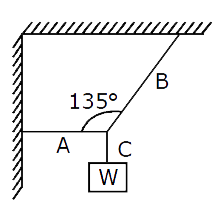Which of the following relations is true?
Y=2η(1−2σ)
Y=2η(1+2σ)
Y=2η(1+σ)
(1−σ)2η=Y
To determine which relation is true among Young's modulus (Y), shear modulus (η), and Poisson's ratio (σ), we can follow these steps:
Step 1: Understand the Definitions
- Young's Modulus (Y): It is defined as the ratio of longitudinal stress to longitudinal strain.
Y=Longitudinal StressLongitudinal Strain
- Shear Modulus (η): It is defined as the ratio of shear stress to shear strain.
η=Shear StressShear Strain
- Poisson's Ratio (σ): It is defined as the ratio of lateral strain to longitudinal strain.
σ=Lateral StrainLongitudinal Strain
Step 2: Relate the Moduli
From the definitions, we can derive a relationship between these quantities. The relationship between Young's modulus (Y), shear modulus (η), and Poisson's ratio (σ) can be expressed as:
η=Y2(1+σ)
This can be rearranged to express Y in terms of η and σ:
Y=2η(1+σ)
Step 3: Identify the Correct Relation
From the derived relationship:
Y=2η(1+σ)
This indicates that Young's modulus is equal to twice the shear modulus multiplied by (1 plus Poisson's ratio).
Conclusion
Thus, the correct relation is:
Y=2η(1+σ)
This means that option 3, which states this relation, is the correct answer.
- Young's Modulus (Y): It is defined as the ratio of longitudinal stress to longitudinal strain.
Y=Longitudinal StressLongitudinal Strain
η=Shear StressShear Strain
σ=Lateral StrainLongitudinal Strain
From the definitions, we can derive a relationship between these quantities. The relationship between Young's modulus (Y), shear modulus (η), and Poisson's ratio (σ) can be expressed as:
η=Y2(1+σ)
This can be rearranged to express Y in terms of η and σ:
Y=2η(1+σ)
From the derived relationship:
Y=2η(1+σ)
This indicates that Young's modulus is equal to twice the shear modulus multiplied by (1 plus Poisson's ratio).
Thus, the correct relation is:
Y=2η(1+σ)
This means that option 3, which states this relation, is the correct answer.
Topper's Solved these Questions
- MECHANICAL PROPERTIES OF SOLIDSBOOK - AAKASH INSTITUTE ENGLISHCHAPTER - MECHANICAL PROPERTIES OF SOLIDSEXERCISE - Assignment(Section-D)
14 Videos
- MECHANICAL PROPERTIES OF SOLIDSBOOK - AAKASH INSTITUTE ENGLISHCHAPTER - MECHANICAL PROPERTIES OF SOLIDSEXERCISE - Assignment(Section-B)
26 Videos
- MECHANICAL PROPERTIES OF FLUIDSBOOK - AAKASH INSTITUTE ENGLISHCHAPTER - MECHANICAL PROPERTIES OF FLUIDSEXERCISE - SECTION - J
9 Videos
- Mock test 03BOOK - AAKASH INSTITUTE ENGLISHCHAPTER - Mock test 03EXERCISE - EXAMPLE
44 Videos
Similar Questions
Maximum and minimum magnitudes of the resultant of two vectors of magnitudes P and Q are in the ratio 3:1. Which of the following relation is true?
View SolutionThe maximum intensity of fringes in Young's experiment is I. If one of the slit is closed, then the intensity at that place becomes Io. Which of the following relation is true?
View Solution
Knowledge Check
For any arbitrary motion in space, which of the following relations are true?
a) vaverage=(1/2)(v(t1+v(t2)
b) vaverage=[r(t2)−rt1t2−t1
v(t)=v(0)+at
d) aaverage=[v(t2)−vt1t2−t1
The average stands for average of the quantity over time interval t1 to t_(2)A→vaverage=12[→v(t1)+→v(t2)]B→vaverage=→r(t2)−→r(t1)t2−t1C→v(t)=→v(0)+→atD→r(t)=→r(0)+→v(0)t+12→at2
The maximum intensity of fringes in Young's experiment is I. If one of the slit is closed, then the intensity at that place becomes Io. Which of the following relation is true?
View SolutionA block of weight W is supported by three strings as shown in figure. Which of the following relations is true for tension in the string ? (Here, T1,T2 and T3 are the tension in the strings A,B and C respectively)

View SolutionEqual molecules of two gases are in thermal equilibrium. If Pa,PbandVa,Vb are their respective pressures and volumes, then which of the following relation is true?
View SolutionTwo circle with radii r1 and r2 respectively touch each other externally. Let r3 be the radius of a circle that touches these two circle as well as a common tangents to two circles then which of the following relation is true
View SolutionThe probabilities that a student passes in Mathematics,Physics and Chemistry are m, p and c, respectively. Of these subjects, the student has a 75% chance of passing in at least one, a 50% chance of passing in at least two and a 40% chance of passing in exactly two. Which of the following relations are true?
View SolutionThe probabilities that a student passes in Mathematics,Physics and Chemistry are m, p and c, respectively. Of these subjects, the student has a 75% chance of passing in at least one, a 50% chance of passing in at least two and a 40% chance of passing in exactly two. Which of the following relations are true? (a) p+m+c=1920 (b) p+m+c=2720 (c) pmc=110 (d) pmc=14
View SolutionWhich of the following relations is correct?
View Solution
